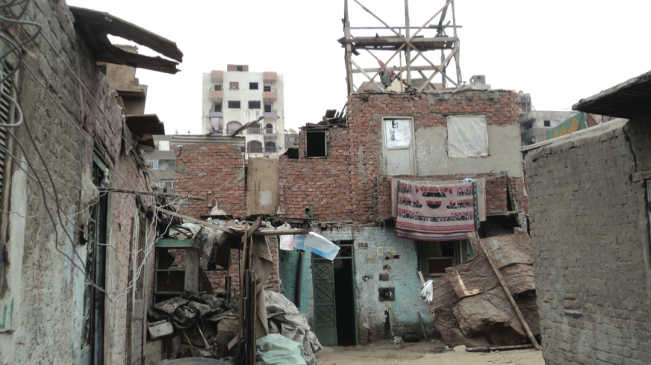
Two grassroots projects work to build up a slum area in Old Cairo with the help of its residents and fresh engineering graduates
By Farah el-Akkad
A bird’s eye view of Cairo shows what appears to be a massive swath of gray concrete. It is quite a sobering perspective, driving home just how heavily built up the capital has become. Just five years ago, in 2010, the UN Human Settlements Programme estimated that half of Egypt’s 80 million-strong population were urban dwellers. Back then the programe projected that by 2025, the country would have an urbanization rate of 59 percent. Today an estimated 60 percent of Egypt’s 94 million population is living in informal housing, with Cairo alone hosting some 41 percent of the nation’s slum population, according to the Social Performance Index. But with the birth rate, unemployment and inflation all spiraling out of control, slums are the only option for families who cannot find affordable housing.
Radwa Rostom is a 2009 civil engineering graduate who might have just come up with a solution to the nation’s slum crisis. Her breakthrough approach is simple: Get everyone involved. In 2011 she started Hand Over, a project that seeks to develop ashwa’iyyat by bringing all the players to one table. Starting with architecture and civil engineering students, Hand Over encourages young engineers to work with residents of local slums to design and build affordable and sustainable homes.
“The answer to such massive problems includes engaging everyone in the planning process, accommodating their needs, planning for future needs as well as using cost-efficient materials to build homes,” says Rostom, who has been interested in community service ever since she was a student. She is currently a fellow of the DO School in Germany, a one-year program that teaches students how to turn innovative ideas into action that creates change.
Having worked with the NGO Alashanek ya Balady (AYB) in college and in the Ezbet Abu Qarn district (a slum area in Old Cairo) since 2011, Rostom wanted to do something not only environmentally friendly but also sustainable. The cornerstone of the project is the “rammed earth technique,” which involves using natural raw materials such as soil, sand, gravel and water to build walls.
“After months of researching and talking with experts in Cairo and Germany, I came up with the conclusion that this technique will provide people with affordable, safe and sustainable houses in little time,” Rostom explains. Houses built using the rammed earth technique tend to resistant to sound, fire and moisture, and have a high thermal mass which minimizes temperature fluctuations.
The Hand Over project focuses on human-centered design, involving local residents in the early stages of the project and paying attention to their needs and expectations so they can take part in and learn the skills needed for the design and construction process.
“I want them to learn how to build their own places and maybe benefit from the process as a business,” Rostom adds.
If properly applied, Rostom believes the project could help solve to the lack of private space and the health problems associated with slum areas. Slum dwellers typically suffer from overcrowding, lack of hygiene and poor mental and social conditions.
According to the Participatory Development Programme in Urban Areas’ 2009 release Cairo’s Informal Areas between Urban Challenges and Hidden Potentials. Facts. Voices. Visions, “The constraints within which informal areas grow, their location on agricultural land or in unsafe geographical areas, the entrepreneurial initial subdivision, and the ex post facto introduction of infrastructure have all led to several major shortcomings in the quality of life for those living there. Also important in this regard are the poor quality of roads and of means of transportation, the poorly ventilated dwellings and the unregulated construction.”
In addition to tackling the problems arising from slum dwellings, Hand Over’s other goal is to engage engineering students around Cairo in community service activities and provide practical experience before graduating. “A group of local and international experts prepares and delivers a comprehensive internship program to the engineering students, introducing them to sustainable techniques of construction,” Rostom explains.
Rostom introduced Hand Over to her friends at AYB and both teams decided to work together and kickstart the project in Ezbet Abu Qarn. “The place is ready and we are taking it one step at a time,” she says. The first phase of the project began in December and will end this month with intensive workshops for students in team building, human-centered design and the social and construction aspects of slum areas. The training will also tackle sustainable techniques of construction, designing concept, as well as project management.
“In its first year, Hand Over plans to create one prototype through the training of a group of 20 engineering students and six local residents for the joint construction of one house in Ezbet Abu Qarn,” Rostom adds.
Hand Over will work in Abu Qarn on a sub-division of AYB’s current Ezbet project, which is working to develop the area by involving residents, academics, students, NGOs and community organizations. While AYB focuses on community service, Hand Over is tackling the housing aspect and empowering engineering students around Egypt. The project is receiving mentoring from the DO School through April 2015.

Comments
Leave a Comment